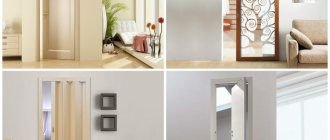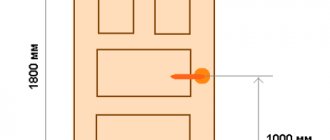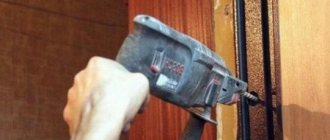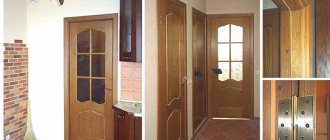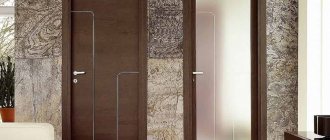Hello readers of my blog! Today we will talk about step-by-step installation of interior doors with your own hands. It would seem that this is not a tricky matter, but when you are faced with this problem, you have to think about how to do it correctly, what preparation to do, what materials to choose. Thus, I decided that this article would be useful to someone, and I am devoting my efforts to this topic. In it I will answer a number of questions that will arise immediately before the step-by-step installation of interior doors with your own hands, and some even after that. This topic is quite broad, because before work, thorough preparation is necessary, but how to do this? And this is a separate topic. You can learn about all this in great detail in the article below.
Do-it-yourself interior door installation
Installing a new door yourself is not at all difficult - if only you had the right tools at hand.
And it’s better to start the experiment with the most inconspicuous doors - for example, to the pantry. We bring to your attention detailed instructions for installing an interior door.
Preparatory work. Before you go to a construction hypermarket or market, determine the budget for the door replacement event. Please note that if you decide to change the doors in the entire apartment, you need to buy them at the same time.
Later, the desired model may be discontinued or there may be no doors of the required shade in stock.
Keep in mind also that an interior door is not just a door leaf!
You will also need a box, accessories, a threshold, platbands, and sometimes handles. The total cost of all this stuff is close to the cost of the canvas itself. If the width of the doorways in your apartment exceeds 110 cm, you will have to either buy a double door (which is more expensive than a single door) or reduce the opening.
In general, carefully calculate the upcoming expenses in order to decide which doors you will buy: solid, veneered or plastic.
Installing the door yourself: step-by-step instructions. Let us immediately note that if you bought expensive solid wood doors, then it is better to install them with the help of specialists.
After all, the cost of possible installation errors is too high. Although if you act carefully, slowly and in strict accordance with our instructions, the risk is small. Remove the old door.
First, use a chisel and hammer to remove the trim. Then use a nail puller or crowbar to lift the door and remove it from its hinges. After that, all that remains is to remove the door fastenings (screws or nails) and remove the frame from the doorway.
Prepare the doorway for installing the new frame.
If there are wooden blocks left in the wall on which the old box was held, then the new one will be attached to them with screws. Otherwise, it is secured with dowels.
Install the new frame into the doorway. Before fixing it in place, check the verticals using plumb lines.
If necessary, drive several wedges between the frame and the wall. Do not forget that the vertical line is set in two planes using a plumb line or level: the door should not go either “forward” or “sideways”.
Secure the box. Drill holes for screws opposite the bars or pre-hammered dowels.
In this case, the through holes should be of the same diameter (the diameter of the screws), and additional holes should be made to a depth of 1 cm with a thicker drill to hide the screw heads and hide these places with plugs. It is enough to secure the side parts with three screws each, and the top with one more.
Hang the door leaf on the hinges. If the box is installed correctly, the door will close tightly and will not open by itself.
Pay attention to the gaps between the box and the canvas: on the left, right and top they should be 2 mm, on the bottom - 4 mm.
Fill the holes between the door frame and the wall with foam. After it dries, install the trim. Do not drive the nails all the way in so that you can bite off the heads.
Install all the necessary fittings: handles, locks, latches, door opening limiters. That's all! Now you know for sure that installing an interior door on your own is not difficult.
Installation of interior doors
Replacing interior doors is not as labor-intensive and complicated a process as it seems. You can fill a double or single opening yourself without the help of a specialist.
Of course, you won’t save time, but you will save money and acquire new skills when renovating an apartment or house.
How to install an interior door: in this article we will tell you how to choose a good door leaf, what the block for filling the opening is made of and how to install it.
Opening measurement
Making a mistake at the stage of measuring the doorway is unacceptable: if you purchase a system of large dimensions, you will not be able to insert it, and if you purchase a smaller one, you will not be able to fix it well.
It is better to measure the doorway after dismantling the old door, when access to the bare wall has appeared.
This way you can assess the situation and make the right measurements. Removing them is simple: take a tape measure and determine the height and width of the entrance along the wall in the narrowest place (relevant for buildings where the vertical structure of the structures is poorly maintained). With this data, go to the store for a new door.
There is no need to make the product according to individual dimensions: in houses with apartments, builders initially lay standard openings, and the fillings for them are always available for open sale.
Interior doors in a private wooden house may differ from the standard ones, then you will have to order new ones and wait for them to be manufactured.
Door selection
The first thing you should pay attention to when choosing canvas and boxes is the material they are made of.
Fiberboard is used to produce budget doors and frames. The material does not protect the room from extraneous sounds, absorbs moisture, and filling will lead to damage during the first off-season.
It is strictly not recommended to choose a frame made of fiberboard; it quickly deforms even under the weight of the door.
MDF is a more reliable material with increased density, average in price-quality ratio.
It is strong enough to withstand mechanical loads, does not absorb moisture, muffles sounds and lasts a long time.
Solid wood is ideal for making and installing a box. It will not be affected by humidity, it will withstand the weight of any door. Laminated wood is additionally lined; untreated timber is not inferior to laminated timber in performance, but it will have to be painted or decorated.
The ideal option is to purchase a box and canvas made of the same material. You should not give preference to wood fiber board; doors made from it are short-lived; they are installed on construction sites so that new owners can replace them with permanent ones made of more durable materials.
Ideally, it is worth acquiring a solid solid material as a door filling; to reduce the cost, the canvas can be replaced with MDF, which is also a durable raw material for the manufacture of cheaper door frames.
Additional strips and trims can be made of fiberboard, wood or MDF. They do not carry a load, they only decorate the gaps and disguise the connections.
Double doors are often chosen for large rooms and halls; single-leaf blocks are installed in bedrooms and kitchens. In any case, the size of the box and the number of panels are determined by the size of the opening.
Foaming
The space between the door frame and the opening is filled carefully, layer by layer with foam. They start from the top. After finishing the work the door is closed.
In the gap (3 mm) between the canvas and the frame, small strips of plywood, MDF or something else are inserted at 2-3 points on each side so that the foam does not squeeze out the frame and block the door.
The drying time of the foam is about a day. If foam gets on the canvas or box from the outside, then it (the foam) should be removed immediately with a dry cloth.
- How to make a heated floor with your own hands - 160 photos and video description of how to make a heated floor
Laying tiles in the bathroom with your own hands: 150 photos of how to lay large areas with tiles quickly and easily
Do-it-yourself slopes are the cheapest and most durable slopes. Instructions and advice from experts (video + 125 photos)
Step-by-step instructions for installing from scratch
Installing interior doors with your own hands will not take much time, just stock up on the necessary tools, purchase the necessary materials and you can get to work. Follow the detailed step-by-step instructions and you are guaranteed success.
This plan is valid for installing swing doors; sliding doors are mounted slightly differently, but in a similar way.
How to install interior doors with your own hands
It is impossible to imagine any home without interior doors. They perform several functions at once.
Installing interior doors is quite simple and will not cause any particular difficulties even if you do the work yourself. Of course, if you wish, you can use the services of specialists.
Materials and tools
The installation of doors begins with the preparation of tools. For installation work you will need:
- To place the door level, you need a plumb line and a level. For measurements and markings, use a tape measure with a pencil.
- The process of assembling and installing interior doors includes final finishing with platbands and, if necessary, extensions. A hacksaw with fine teeth and a miter box are useful for cutting planks.
- The power tool you need is a drill with a set of drill bits for concrete and wood, as well as a screwdriver.
- It’s easier to make cuts for fittings with a milling cutter, but if you don’t have a tool, you can get by with a chisel and hammer.
The materials used are self-tapping screws, polyurethane foam, and also many wooden wedges of different thicknesses for spacers. You need to immediately decide how to install interior doors so that the fasteners are not visible.
If preference is given to hidden installation, additional hangers are purchased. You can fix the boat with anchors. Sink the caps into secret holes, putty them, and paint over them.
Choosing an interior door
In principle, this does not affect the technology of installation work in any way. But their cost depends on the type of door, and the service life of different types of doors differs significantly.
paneled interior doors. If they are made of hardwood, then they can be considered almost a luxury item.
In addition to their main function, they decorate the room. The only disadvantages include high cost and heavy weight. For interior doors, paneled doors are more often used, but made of soft wood;
As for the installation technology, to make the work easier, it is recommended to purchase the door complete with a door frame.
A price that is too low is suspicious. Most likely, in this case, the door is sold without a frame; in the end, this will greatly complicate the installation of the interior door.
How to properly install an interior door - step by step
Before installing the door itself, the door frame is installed. If it was purchased together with the door, then most likely its ends are already sawn at an angle of 45°. In this case, all that remains is to assemble the box into a U-shaped structure.
Depending on the configuration, the set may also include an additional strip. It will be used to securely fix the door frame until final installation.
The door frame elements can be connected using either self-tapping screws or plastic dovetail keys. They usually come with a box.
When assembling the box, special attention must be paid to ensure that no element moves relative to the other. Otherwise, all the work will go to waste.
Before installing the door frame, it is advisable to select all the necessary grooves in the wood for awnings, installation of door handles, and a lock. It is much more convenient to do this while the box is not yet installed.
Also, before installing the frame, you need to shorten the side posts along the length of the door. It is important to ensure a gap of 10-15 mm between the door and the floor of the room.
To ensure that the door frame does not deform at the bottom when performing work, an additional strip is placed on the screws.
It needs to be attached to that part of the box that will be hidden after final finishing. The screws are screwed in obliquely so as not to split the wood.
There must be a gap between the frame and the doorway; wooden wedges will be driven into it for temporary fixation, then the free space will simply be filled with foam. But this will happen after the final fitting of the door.
First, the door frame is attached to the wall with a self-tapping screw or dowel only in the upper part. Moreover, the mounting location should be in the groove for the canopy. Then the canopy will play the role of a decorative overlay.
After fixing the top of the box, its bottom is carefully controlled, then, using the same principle, fixation is performed from below. Additionally, the box is secured using wedges, which are driven in at the top at the level of the crossbar and at the bottom at the level of the temporary spacer.
This is followed by fitting of the door; the frame is not yet fully secured.
The door is hung and the smoothness of movement and the verticality of the door itself are checked. Sometimes, even with careful adherence to technology, the door itself opens or closes, which indicates a slight vertical deviation. In this case, additional adjustment of the position of the door frame will be required.
If everything is in order, then you can fill the voids between the door frame and the wall with foam.
Before doing this, it is better to insulate with masking tape all wooden surfaces that may come into contact with the foam. It will be very difficult to remove it later without damaging the tree.
To ensure maximum adhesion, concrete must be cleaned of dust and dirt.
After foaming the voids, you must take a break for 12 hours. Then the excess foam is cut off with a knife and installation of the trim and trim begins.
The additional strip should cover the distance from the edge of the wall to the door frame. It can be attached to the box with self-tapping screws, and the planks are connected to each other (if you need to use several panels in width) using a tongue-and-groove pattern. Existing voids also need to be filled with polyurethane foam.
After this, all that remains is to attach the platbands. At the joints they are sawed at an angle of 45°.
Platbands can be attached either with glue or with ordinary nails without a head. Platbands with a special protrusion are also produced, which are simply inserted into the corresponding groove on the door frame. In this case, you can do without nails and use only glue.
At this point, the installation of interior doors with your own hands can be considered complete. If the described technology is followed, the quality of the installation will be comparable to the work of professionals.
Installation of interior doors
The instructions for installing interior doors allow you to install such structures yourself without much difficulty. You just need to strictly follow its points.
Carrying out the main stages and choosing decoration options
After the door frame has already been installed in the opening, we begin to manufacture the door leaf. The step-by-step production of a simple door involves the assembly and fastening of ordinary boards with a thickness of 10-25 mm, already adjusted to the required parameters, using the tools and materials indicated above.
When the base is ready, start finishing. There are a lot of decoration methods, but their selection should be made depending on the required weight of the structure.
MDF panels and lining can be used as decorative materials.
Do-it-yourself door installation - let's evaluate the scope of upcoming work
Door structures between rooms in an apartment or private house cannot be called very complex technical systems. However, their assembly and installation require knowledge of a number of nuances.
- Firstly, a door installed by yourself should not open spontaneously.
- Secondly, it must close without excessive effort.
- Thirdly, door structures must have a certain strength and not fall apart in cases where they are installed in the homes of “lovers” of slamming doors.
A regular door block consists of two elements – the leaf and the frame.
The latter is made of loop and false beams, as well as a lintel. If you install doors with a threshold, the frame is supplemented with a special bottom bar. In most cases, the door leaf is hung on two hinges.
There are systems with three loops, but they are used extremely rarely. The set of door blocks, as a rule, includes platbands. If the manufacturer does not provide these, you will need to purchase them separately.
In situations where the door frame is smaller in width than the door opening, you need to purchase additional panels or trim the walls with strips or more elegant slopes from a design point of view. Here you need to know that professionals do not recommend plastering slopes if you are installing structures made from wood materials (for example, MDF) with your own hands. Such doors simply become deformed after applying the plaster composition to them.
An excessively wide opening is often reduced with the help of wooden beams. Its dimensions must correspond to the “extra” width.
Such a beam is installed on the side of the door post, where its hinges are located. The beam is attached to the rack with small cross-section universal screws, and it is connected to the wall with anchors. It is recommended to do the installation of interior structures with your own hands after the pre-finishing of the room (it is assumed that you have leveled the walls, carefully and carefully puttyed them, and then plastered them).
Reducing a doorway using a wooden beam
In other words, the assembly and installation of doors is carried out after completion of all “wet” finishing work without exception.
Otherwise, there is a high probability that the system may “float” due to high humidity.
You definitely need to arrange the subfloor, as well as decide on the thickness and type of finishing floor that you will make. Without this, you will not be able to accurately mount the door frame to the height of the threshold. If you simply decide to change the interior doors in a room where no repair work is being carried out, the latest recommendations do not matter.
Assemble the door frame
- Place the side posts of the door frame along the edges of the door to avoid confusion. They should be facing a quarter towards the door hinge. That is, you should see the seals.
- Calculate the height of the post for proper trimming. It consists of the size of the leaf (2,000 mm), the gap between the frame and the door (3 mm), the thickness of the frame itself (22–25 mm) and the gap between the leaf and the floor (8–22 mm). The lower threshold is made only in bathrooms; in other cases, a gap is left for carpets and other coverings.
- Calculate the width of the door frame crossbar. To do this, add 6 mm to the width of the door leaf, so that you end up with a gap of 3 mm on each side.
- Carefully cut all planks to size. It's better to use a miter saw, but you can also use a fine-tooth hacksaw.
- Remove the quarters on the side posts to mate with the top rail. To do this, move the seals to the side, make cuts with a saw, and then chop off the interfering pieces with a chisel. Use scraps of the box as a template for greater accuracy.
- Trim the rubber seals on the side posts at a 45-degree angle to avoid an unsightly gap after assembly.
- Place the frame strips together, align the edges and fasten with screws. Pre-drill holes for screws and screw two into each rack. Use box scraps for precise markings.
Installation of racks and hinges - step-by-step instructions
It is very important to install the racks correctly.
The door frame is attached to them. If you install it on crooked racks, the operational functionality of such a door will be minimal. The racks are prepared as follows:
The upper parts of the racks must be cut using a hacksaw (it is better to take a saw with small teeth) and a miter box. This operation is easier to do if you have a miter saw. Measure the required length along the inside of the post (it consists of the bottom gap, the height of the door leaf and the top gap).
The bottom gap is usually taken to be about 1 cm, the top - no more than 0.4 cm. Prepare the second rack in the same way.
Now you start processing the lintel. Measure the desired length along the inside.
The required length will include the width of the door leaf, a small (about 0.4 cm) gap on the side where you will put the lock on the door, and another gap on the hinge side. You get the length (internal) of the lintel. Note - absolutely accurate.
Installation of interior door posts
Now you can saw off the ends of the lintel with your own hands (again, with a miter saw or miter box). This procedure is done at an angle of 45°. Next we work on the door hinges.
Their installation should be done as carefully as possible. It is important to determine the exact depth of their depth and the distance between the lower and upper edges of the door leaf.
You have completed a difficult task on your own. Now you can work on the box and trim.
How much does it cost to buy a set of interior doors?
For the same Concept doors of the 500 series, the price indicated on the website is RUR 5,242. It is clear that this is the price for one canvas. How much will the whole set cost? It is not difficult to calculate, since the composition of the kit and the price of the moldings are indicated here.
For a normal standard case (no extras needed) you will need 2.5 box strips (2 vertical and one short horizontal top). 1 piece costs 722 rubles, which means for 1 door the price of the box will be 1,805 rubles.
This also includes 5 strips of platbands (2.5 on one side of the opening and 2.5 on the other), each costing 462 rubles, which means all the trims of 1 set will cost 2,310 rubles.
So, a set of interior doors with a frame and platbands will cost 9,357 rubles. And these – please note – are very inexpensive doors. A complete set costs almost 2 times more than one canvas. And if you order accessories for it right away, the price will be even higher.
Do-it-yourself door frame assembly and installation
Installing the box yourself will be quite simple if you adhere to the following order of work.
Attach (strictly perpendicular) the rack to the ceiling using universal self-tapping screws.
If you are installing an interior product made of MDF, in order to avoid cracking, you first need to make holes with a drill and only then install the screws.
Important! The holes are made with a smaller cross-section than the diameter of the hardware used.
Place the box in the opening, and then securely fix it using spacers and wedges.
Take a building level and level it along the horizontal and vertical planes of the structure. After that, feel free to use self-tapping screws. Hang the door on its hinges.
It can be inconvenient to perform this procedure on your own, so call an assistant. After hanging, check the quality of installation, eliminate any installation defects, if any.
Close the interior door, install spacers of suitable sizes between the posts and the door leaf. They will protect the box from being squeezed out when blowing out the foam.
The last step is foaming the gap between the wall and the door frame.
Once the foam has hardened, the spacers will need to be removed. All you have to do is install the trim yourself. Everything is simple here - you cut a 45° angle and mount the elements in their place.
It is recommended to fasten the installed platbands: with self-tapping screws; special nails (they are called finishing nails); on glue.
It is advisable to cover the tops of the screws with decorative plastic plugs. And the heads of the nails are usually rubbed down. Congratulations, you have installed interior doors yourself, saving a lot of money on the services of specialists!
DIY installation of interior doors
Installing interior doors with your own hands is easy on the one hand, but not very easy on the other, it all depends on how you approach this issue.
If you are thoughtful and deliberate, then everything will go easily; if you try to take it forcefully, then most likely you will not succeed.
Let's face it - it is more important to know the theoretical basis here than practice, although it also has a significant influence.
How to do the work with your own hands?
Door frame fastening
The door frame, or also called the jamb, is a frame made of beams on which the door is mounted. The box can be installed in a U-shaped or rectangular shape.
- Rectangular is suitable for bathrooms or toilets.
- The U-shape is needed when there is no threshold.
Manufacturers produce box timber in a certain sequence. Special production technologies with finished pieces are used. These segments have standard sizes for the selected structures. They are fastened with a screwdriver and screws of the required length.
When making it and tightening the parts, the door must be kept in a horizontal position. To do this, place it on a flat table or even on the floor. Sawing of box parts and their arrangement will then be carried out according to more precise dimensions.
Box parts can be connected in two ways:
- Using the lintel and pillars, I sawed down at an angle of 45 degrees. This method is labor-intensive and its use is not recommended for beginners who have not dealt with such work. The parts are connected with ordinary self-tapping screws. To properly connect the parts, it is necessary to make holes perpendicular to the cut. To prevent the workpiece from deteriorating, the holes are made in advance before all other installation steps are performed.
- The part is cut at a right angle with a hacksaw with fine teeth. To determine the vertical size of the bar, take the height of the leaf and add 3 mm to it at the bottom and top, provided that the doorway has a threshold. If it is absent, leave 1 centimeter below. In this case, the ceiling is attached with two self-tapping screws to the vertical post.
Advice
The gaps between the box and the canvas must be maintained (3 mm each). U-shaped boxes require a cutout of 1 cm. This is the distance between the floor surface and the edge of the door below.
We invite you to watch a video about assembling the door frame:
Insertion of hinges
The quality of door opening and closing depends on the assembly stages. The more smoothly they are done, the better the quality of the canvas will be at the output.
- It is necessary to mark the installation locations of the hinges from the top of the door. You can use mortise or overhead hinges.
- The racks, which are prepared in advance for work, and the crossbar at the top should eventually be connected. They are tightened with self-tapping screws 6 cm long. One joint may require the use of 3 or more self-tapping screws. It is not advisable to use a smaller amount to avoid poor fastening of parts.
- To connect the parts more tightly, part of the box element is removed with a chisel or hacksaw. The length of the part that is removed must be equal to the thickness of the block, which must fit tightly to the part.
You need to install 2 hinges on the door, in some cases - 3. Installation begins after maintaining a spacing of 200–250 mm from the edge of the door leaf. Knots in wooden parts should be avoided.
Operating procedure:
- Loops are applied to the selected location and their contours are outlined. This is done with a sharpened pencil or knife blade.
- If you have a router, you can use it in your work. The tool is simple and easy to use. If it is not available, you can use a chisel and a material selected for the thickness of the loop.
- The loop is installed vertically in the prepared recess. Its plane should be flush with the surface of the door.
- Self-tapping screws are used to secure the hinges, aligned according to pre-made marks.
We invite you to watch a video about attaching hinges:
Installation of the stop
Sequence of work when installing the stop:
- Tools are being prepared. When installing a door limiter, you need to have a hammer drill, a simple drill, a pencil, and a screwdriver. When a stopper is purchased, its completeness is immediately checked. It is important that a special screw and dowel fit the door latch, fixing the position of the first one.
- Choosing a location for the door stop. The location of the limiter is important for its reliable fixation. It is necessary to open the door slightly so that a distance of about 5 cm is maintained. The distance from the door to the wall should not be less than the length of the handle. Otherwise, the door stop will not be able to prevent the door from hitting the wall.
ImportantThe installation point must be determined using certain parameters. For example, if the room is residential, then the plug should be tight, but if not, then its distance from the wall to the doorway does not matter.
- Marking in progress. Mark the future placement of the door stop with a pencil on the floor. After carefully checking all distances, the door is closed and holes are made in the base.
- There should be 2 holes in the floor. One will be fixed with a dowel, the other will be applied under the pin. On a wooden floor this whole procedure is quite easy to perform. A concrete foundation requires a lot of time and physical effort. The tile is subject to deformation, so after drilling you will have to repair the cracked tile.
- The door opening angle limiter is mounted according to the specified dimensions. The dowel is driven into the bottom of the holes. The door stop is in its place. A screw is used to fix its balance and check that it does not touch the wall when opening the door.
- Varnish painting. To preserve the shine and shine of brass stops, they are varnished after all work is completed.
Assembling the accessories
Simple additions are connected:
- foam;
- nails;
- self-tapping screws.
Experienced builders can perform the procedure using foam.
The extensions serve as a platform for attaching platbands, which must be properly attached. To do this, the end of the extensions must be in line with the plane of the wall. Measurements are taken on the installed door frame.
- A slot is made on the extensions for future fastening with self-tapping screws. The thickness of the board should be about 10 mm. For work, take a drill with a diameter of 9 mm. The diameter of the caps should change with the diameter of the screw caps. They should fit into the door frame 2-3 turns. If this distance is not maintained, cracks may appear at the joints.
AttentionDrills should be matched to the wood and have thin needle tips. This will allow you to accurately center the hole and prevent the drill from moving during drilling.
- After drilling holes for the screws in them, they are inserted until the ends appear on the opposite side.
- First, the vertical extensions are screwed on, and then the horizontal ones.
- After checking the correct position of the parts, the places that stand out for loose fit to the door frame are checked.
Using any available materials, everything is attached close to each other enough to meet all the parameters. It is necessary to observe the degree of deflection of the extensions. If this happens, the structure will be installed with visible defects or even mechanical failure. - After treatment with polyurethane foam, wait about 24 hours and cut off any excess that appears with a sharp knife.
- The stability of the installed parts is checked by tapping. If creases or voids are detected, polyurethane foam is added again and the required time is waited for it to dry.
We invite you to watch a video about the assembly and installation of accessories:
Fastening platbands
There are several ways to attach platbands to interior doors:
- Finishing nails. Wooden cashing is nailed with nails with flat heads. This ensures reliable fastening and easy removal of the strip. If there are no nails without heads, then you can also use them and remove the tops with side cutters. The length of the finishing nails is about 40 mm. In general, the size is determined taking into account the thickness of the cash.
- Liquid nails. This adhesive is used for relatively flat walls. After sawing the workpieces, the plank is smeared on the back side and pressed tightly against the wall.
AdviceEach plank is held for about 40–50 seconds.
- Self-tapping screws. Take wood screws measuring 25 mm in length and 6 mm in thickness. The workpieces are marked for holes with a pitch of 500 mm. The drill is used to maintain a margin of 1 mm. In this case, the hats are completely sunk into the recess, and the place of fixation is painted over with a wax pencil.
- Fastening with beaks. The cash box is equipped with a lock shaped like a beak. The connecting pin is inserted into the recess on the box and pressed until it clicks. This method is simple. After such fastening, the connection point is not visible. Over time, spontaneous separation of joints from fasteners may occur, but even here you can be on the safe side by using joint adhesive for the work.
If the door is in a corner, installation is carried out using the letter G. You can saw the element vertically and use a narrow strip. The platband on one side is installed when the slopes on the other are decorated with tiles or other wall materials.
We invite you to watch a video about installing trim on finishing nails:
Handle installation
- First, markings are applied. The height of the handle is calculated, marks are placed on the door in the places where the holes are drilled. To do this, use a simple pencil, tape measure and corners. A horizontal line is drawn and transferred to the end in the opposite direction of the sash. A mark is placed on the end part, which will indicate the place for the recess under the tongue. A point is drawn on both surfaces of the door at a distance of 0.6 cm from the edge of the leaf.
- The opening for the handle must be drilled with a drill and a crown. For accuracy, you need to use a felt-tip pen.
- To cut a latch into an interior door, you need to take a drill and a feather. The gap is quite small, so the work must be done carefully. The cover is pressed against the end and inserted into the required opening. Cleaning of excess elements is carried out with a chisel. The trim is secured with screws, and the recesses must be drilled before installing the handle.
We invite you to watch a video about installing a handle on a door:
Foaming
When performing foaming, you need to follow the following algorithm:
- Before using foam, you need to take care of the spacers on the door leaf. Foam sufficiently increases the volume of the door space, so even simply installing cardboard from the door packaging will help avoid unnecessary expansion.
- The container is shaken and moistened with water. In this case, the section of the box must also be moistened. This procedure will give the necessary adhesion to the foam and speed up its hardening. You need to work with the cylinder carefully, keep it in a strictly inverted position.
- It is important to monitor the temperature in the room. The range from +5 to +30 degrees is the most favorable. With these indicators, the work can be performed with the usual type of material. At temperatures ranging from -10 degrees and below, work should only be done with high-quality all-season material.
We suggest watching a video about foaming the gap between the wall opening and the door frame:
Do-it-yourself installation of interior doors: preparatory work
Before you begin directly studying the technology for installing interior doors, you first need to understand the preparatory work. If you ignore this stage, then the elementary and simple installation of doors will turn into a nightmare for you. There are two points to consider here.
Doorway. It is better to immediately check it for full compliance with the door block.
It will be good if, when installing the block in the opening, a two to three centimeter gap remains on all sides. It will allow you to position the block as it should without any difficulty - that is, level and in plane with the wall. Everything is simple here - if the opening is small, then it needs to be expanded using a hammer drill.
If it is large, then it can be framed with a wooden beam. For example, if we are talking about five-centimeter gaps around the perimeter of the block, then this is normal - if more, then you need to narrow it.
The door block itself. There is one trick here, thanks to which the independent installation of interior doors goes, as they say, without a hitch - you will need to make a simple device.
Namely, sew two even slats across the door frame (top and bottom), which will allow you to install the block clearly in the plane with the wall. In order not to damage the frame itself, to fix these jumpers, you can screw wooden plates into the end of the door frame, to which you attach the jumpers.
By the way, their length must be calculated so that after installing the block in the opening they will rest on the wall.
There are a couple more nuances here that you can’t do without: firstly, these jumpers need to be sewn on the opening side of the doors and, secondly, they need to be sewn on only when the gaps between the door leaf and the frame have been set.
The gaps can be fixed with thick cardboard folded in half. Without these two points, it is not worth proceeding with the direct installation of doors, since the probability of the block being misaligned during the installation process is close to 100%.
Only after all these manipulations have been completed can you safely proceed to installing interior doors yourself.
Dimensions and equipment
Interior doors are produced in standard sizes, it’s just a pity that standards differ in different countries. For example, in our country, swing doors are made 600 - 900 mm wide with a pitch of 100 mm. In some EU countries the rules are the same - in Germany, Italy and Spain. In France, others are standard. Here the narrowest doors are 690 mm and then in increments of 100 mm.
Is the difference really that important? If you want to change only the door leaf without the frame, then it is important - you will have to choose from your segment or completely change it along with the frame. There is a much greater choice of interior doors of the same standard as in our country, while in France there is much less choice.
Recommended door leaf width for different door frame sizes
What width of doors you need depends on where you are going to place them. If we talk about standards, the following values are recommended:
- in the living room width from 60 to 120 cm, height 2 m;
- bathroom - width from 60 cm, height 1.9-2 m;
- in the kitchen, the width of the door leaf is at least 70 cm, height 2 m.
If, when replacing a door, you decide to make the opening larger or smaller, you do not need permission for this, but you must remain within the limits specified for each room.
How to determine what width of doors to buy? Measure the door leaf you have and you will know what you need. If there are no doors, find the narrowest place in the opening, measuring it, you can find out how wide the door block you need. This is a door leaf + door frame. So the outer dimensions of the door frame should be less than the measured value. For example, you got 780 mm, look for a block with parameters of 700 mm. Wider ones cannot be inserted into this opening.
The most complete set of interior doors - with frame, extensions and trims
When choosing a door, pay attention to the equipment. There are three types of assembly:
- Door leaf. You buy the box separately.
- Doors with frame. Everything is included, but the box is in the form of separate boards. You will have to file the corners and connect, hang the hinges yourself.
- Door block. These are ready-to-install doors - the frame is assembled, the hinges are hung. Just cut the sidewalls to the height, align them evenly and secure them.
Even though the quality of the door leaf is the same, the prices for these kits differ significantly. But the difference in the time you spend on installation is significant.
Installing interior doors with your own hands: step-by-step instructions
After all the preparatory work has been completed and the tools for installing interior doors have been prepared, you can begin installation. As for the tools, you will need a few of them: a hammer with a wooden handle, a short rack level (up to half a meter), a crowbar and a container of polyurethane foam with low polymerization pressure (for example, Macroflex 65) and wooden wedges. Once you have all this at your fingertips, you can act.
Now let's look at the process point by point.
We install the door block in the opening. To begin with, pay attention only to which side you are installing it on - that is, on the side in which the doors will open.
Center the block in the opening. By moving it to the left or right, we achieve uniform gaps between the frame and the opening on the left and right.
Place a level under the top jumper and see how it is positioned. If necessary, we achieve its clear horizontal position by using a crowbar to lift one of the door frame pillars and place a wedge under it.
In principle, if the preparation of the door block was carried out correctly, then the verticality of the racks does not need to be checked - everything should be in order anyway. But just in case, you need to check.
We attach the block to the wall. Through the protruding parts of the lintels that rest against the wall, we drill holes with a diameter of 6 mm and hammer dowels into them.
During the fastening process, you need to periodically (after installing each dowel) check whether the position of the door block has been disturbed.
We wet the frame and the end of the doorway with water - this step is necessary in order to improve the polymerization of the polyurethane foam and its adhesion to the opening.
Last check. We make sure that the doors are still in place as they should be. This is done with a rack level.
Also check the presence of all cardboard spacers between the canvas and the box - if necessary, replace those that fell out during operation.
Blow out the gap with foam. I think you can figure this out for yourself. If you purchased the right foam, then you don’t have to worry about it squeezing the box.
Now wait a few hours until the polyurethane foam completely hardens (usually 6-10 hours) and remove the now unnecessary auxiliary devices. We take a screwdriver, first unscrew the dowels, then the self-tapping screws that secure the jumpers to the door frame, then remove the slats themselves or the profile (or whatever you used) and open the doors, enjoying their flawless work.
The gaskets will fall out when you first open the doors, so all you have to do is pick them up and throw them in the trash.
As you can see, everything is simple - the correct installation of interior doors eliminates a lot of questions, and most importantly, allows you to complete this process with minimal effort and nerve tension. And in conclusion, a few words about other technologies by which you can install interior doors yourself.
It’s hard to say that they are complex - this is where initial experience most likely comes into play. Initially, a person learned to do this work exactly this way, and in no other way, and all other methods seem more difficult to him. One of the craftsmen can say the same thing about the installation method described above.
Why such difficulties? Why all these devices and unnecessary body movements, if everything works out just fine without them? I won’t argue - do as you wish, but personally, I made my choice in favor of this option through trial and error, having tried other options.
Installing the door frame.
The interior door frame can be installed in two ways: using fastening metal plates or using self-tapping screws with a dowel. The figure below shows these 2 methods at once.
Door frame fastening diagram.
Fastening the door frame with mounting plates.
The use of fastening plates, which are used when installing drywall, is only possible if the walls have not yet been finished. It will be necessary to hollow out small recesses in the wall for the plates, which will then be covered with putty.
Fastening the door frame with mounting plates.
The plates are screwed onto the back side of the box using 3x13 self-tapping screws with a press washer.
As you can see in the picture above, the plates are attached in the places where the hinges are installed, opposite the hinges and one plate on top approximately in the middle of the box.
Fastening the door frame with self-tapping screws and dowels.
The method of fastening a door frame using a self-tapping screw with a dowel involves through-drilling the sides of the frame. But so that the heads of the screws are not visible, they are installed in certain places. Two self-tapping screws are installed under the hinges, and one self-tapping screw is installed in the place where the strike plate will be located under the door latch tongue.
To hide the screws under the hinges, you need to drill holes with a diameter of 3 mm in advance at the place where the hinges are installed, and then drill them out a little to form a small recess for the head of the screw.
Drill holes for the mounting screw.
In the place where the latch tongue will be located, we simply drill a hole with a diameter of 3 mm. There is no need to make a recess under the screw head. At this point, securing the box with a self-tapping screw will be temporary. After fixing the door frame with foam, this screw will need to be unscrewed. Then the latch striker will cut in here. In this place, one polyurethane foam is enough to fix the frame, and on the side of the hinges, where the door frame will be loaded with the weight of the door, the fastening will be reinforced with self-tapping screws.
Door frame installation.
- We install the door frame in the opening.
- Make sure that the inside of the box (towards which the door will open) is flush with the wall.
Align the door frame with the wall.
- We wedge the top strip in the door opening and check its horizontalness with a building level. You can use any scraps of boards or door frame posts as wedges.
The top bar of the box is wedged in the doorway.
- We fasten the vertical post of the door frame with self-tapping screws from the hinge side.
- We wedge the stand from the hinge side and check the level in two planes (we apply the level inside the box and on its side).
- We fasten the second pillar of the door frame with one self-tapping screw. We check it with a building level. We also make sure that the distance between the posts at the top is equal to the distance between the posts at the bottom.
- We wedge the second rack.
- We hang the door on the door frame. The hinges must first be screwed onto the door. It is convenient to hang the door open and place some kind of lining under its edge.
We install a lining under the edge of the door and hang the door on the door frame.
We hang the door on the door frame. First we screw the top hinge of the door, then the bottom one.
- We check that the door is installed correctly. An open door in any position should not budge. This indicates that the door is installed correctly.
- We close the door and install 3mm thick pads between the door leaf and the door frame pillars. We also install linings at the top of the door. At this stage, the door frame pillar, which was fastened with one self-tapping screw, may be out of place. The gap between the door leaf and the pillar may be too small or large. In this case, we move the stand to the desired position by unscrewing and tightening the screw and wedge the stand again.
- We fill the gaps between the door frame and the opening with polyurethane foam.
We use polyurethane foam.
Interior doors can be divided into several types
Manufacturers of door structures on the market offer a fairly wide range of models. Ready-made interior doors can be made of different materials. The most common types of materials are: fiberboard, MDF, natural wood.
1.Fibreboard – door: the frame is made of wood and covered with laminated fibreboard sheets. The advantages of such doors include: low cost compared to other types, light weight, which makes it possible to deliver them from the point of sale to the house on your own, and ease of installation. Considering these points, they are popular among customers, thanks to which their wide range is most often presented in stores.
Among the disadvantages, we can note the low strength of the fiberboard itself, which is why the door breaks and becomes unusable quite easily, poor resistance to humidity, the door can twist. Therefore, we do not recommend installing it in bathrooms with weak exhaust; this material loves dry rooms.
Below, we will consider the step-by-step installation of interior doors with our own hands.
2. MDF - doors that are made from this type of material are the most suitable option when choosing the ratio of quality and price. Clear advantages over doors made of fiberboard are high strength and resistance to moisture, and a higher level of sound insulation. The cost of such a door is several times higher than doors made of fiberboard.
3. Natural wood – interior doors made from this material are the most durable.
Their price directly depends on what type of wood was used for their production. Doors made of valuable wood species are used for installation in rooms with an original design; they will fit perfectly into a classic interior. The width of interior doors is adjusted to the size of your opening.
The list of interior doors by type can be supplemented with all-glass doors, metal-plastic, steel, but these types are not very popular among the general public, so they are not included in the article for a detailed description.
Types of door frames for interior doors
The correct interior door should be placed in a reliable door frame, because its quality will determine how long the door will last, as well as the design of the doorway of your room. Door frames can be divided into three main types.
1. Fiberboard box. It looks pretty decent, but when choosing a box made of this material, the strength of the entire structure will be in question.
The middle of the frame bar sag from its own weight, not to mention possible deflections from the weight of the door leaf itself. Since the main components of fiberboard, to put it simply, are glue and paper, it must be taken into account that they are very fragile and not durable. It is not recommended to hang doors made of wood and MDF on them due to their heavy weight.
2. Box made of untreated wood.
The cost is at the same level as boxes made of fiberboard, but unlike the latter, boxes made from dry profiled timber have higher strength. Therefore, when choosing between boxes made of fiberboard and boxes made of untreated wood, we recommend choosing the latter.
It is also necessary to take into account that you will need additional materials to finalize the box.
3. Laminated wood box. Does not require final finishing, as it is already laminated with paper.
And here there is one important point: when choosing such a box, the quality of lamination is very important. If thin paper was used for this, there is a high probability of scuffs, scratches, cracks, and the coating loses its appearance.
Perhaps a better option would be a box made of untreated wood with independent finishing and painting.
Also, the entire interior doorway may require additional processing after the doors are installed. Everything depends on your opening, its size, the location of the door in it, and the interior of the room.
For such processing, you can use additional strips and platbands.
The necessary kits can be purchased at the store. We recommend that you determine whether they are necessary after the final installation of the door in order to understand what kind of final finishing you need. After all, purchasing additional materials is an additional expense that may ultimately turn out to be unnecessary.
Well, now it's time to finish the article. All the material I wanted to share has been reviewed. I hope it will be useful to you, and you will use it if you need a step-by-step installation of interior doors with your own hands. Improve your own practical skills and gain new knowledge, they say: “It’s never too late to learn!” That's all, thank you for your attention, successful and easy repair!
Preparation stage
Personally designing or assembling something requires careful analysis of many factors and selection of the most appropriate option.
Material
Considering the organization of production at home, the best option is wooden doors. There are interior models on sale made from different materials - plastics, glass, aluminum - but working with them requires not only experience, but also special tools. In addition, wood has an undeniable advantage - it is able to “breathe”, which has a beneficial effect on the microclimate in the house.
Engineering solution
Interior doors are divided into several types - hinged, folding, sliding (compartment). The models also differ in design - single-leaf, double-leaf, and one-and-a-half-leaf. Some of them have an upper extension - a transom. What is it advisable to focus on? Without professional skills, special tools, or machine equipment, you should choose a swing interior door with one leaf.
These are the most popular varieties installed inside apartments and private houses. If you study the step-by-step instructions for constructing doors of all types, then it is the swing “one-room doors” that are easier to manufacture. In addition, preparing the opening for their installation does not require complex technological operations.
Blade type
- Paneled. The advantage of interior doors in this category is their relatively light weight. The canvases consist of a wooden frame and inserts, which differ in size, material, and shape. The difficulty is that the panels will have to be fixed to it, and for this you need to select quarters in the tree. Even with professional tools (equipment) at hand, independent production of interior doors of this type (if we mean quality) is a big question. To achieve the desired result, you will have to spend a lot of time and material, the consumption of which will be significant, since the volume of rejection will increase.
- Shield. This solution is optimal. The only downside is the weight. But this problem can also be solved if you choose boards of small thickness. Since we are talking about interior doors and not entrance doors, the strength of the door leaf is not a primary factor. But there are many more advantages: ease of assembly, the possibility of any finishing (varnishing, tinting, brushing, lining with plastic, decorative film, natural veneer - different design styles are practiced), high maintainability.
In addition, the door dampens noise well and is characterized by low thermal conductivity. There is another factor that many people overlook. Wood is prone to deformation (it “plays” under the influence of changes in humidity and temperature in the house). A solid door is less susceptible to this than a paneled model, especially if the inserts are made of a different material. For example, glass, plastic.
Lumber
- The type of wood does not play a big role if subsequent finishing of the canvas and frame is planned. You can partially save on this by choosing inexpensive products. But if you decide to make a door from boards while maintaining their texture, then the answer to the question of what to buy is obvious.
- Degree of wood drying. According to SNiP, lumber with a moisture content exceeding 22% cannot be used in construction. When applied to doors, experts advise focusing on 10 - 12. Wet wood will shrink and the structure will “lead.” If the samples are thoroughly dried, then, firstly, they will cost more, and secondly, there will be difficulties with cutting them. In addition, excessively dry wood easily splits, and this will cause problems with fastening fittings and inserting locking devices.
Varieties and dimensions
- Frame. A beam with a side of 40 - 50 mm is sufficient for the frame of the canvas. It is necessary to take into account the installation location of the door, that is, how intensively it will be used. Plus - the specifics of the room at the entrance to which it is installed; Is the door supposed to be equipped with a lock, and if so, what type. The latter fully applies to canopies.
- Canvas. To reduce the weight of the interior door and facilitate the manufacturing process, it is advisable to use MDF for covering the frame. Another argument in favor of this solution is that the slab material (if it is of high quality and carefully processed) is inert to humidity and temperature. If you want to make a door from solid wood, 10 boards with a width of 150 are suitable.
- Box Rarely does anyone leave an old joint in place. If a new door is being assembled, it must be completely complete. When choosing timber, you need to take into account the thickness of the wall (partition) at the installation site. There is no other recommendation for this item other than sufficient strength of the jamb.
The choice of material is largely determined by the door drawing. The interior door leaf is made in different ways; it can be solid, hollow or “cellular”. The last option is called small-hollow.
Door diagram
- Dimensions. The initial data for calculations are the dimensions of the opening. For accuracy of calculations, its width is measured at 3 levels; similarly with height - at three points (on the sides and in the center). It is worth considering that a technological gap of 4±1 mm is left between it and the box around the perimeter. This is the outer contour of the jamb. Provided that the width of the canvas is of decisive importance, then everything else is calculated based on its required dimensions. In this case, the gap between it and the jamb (within 1 mm) is also taken into account.
In practice, it is difficult to make wooden doors with your own hands, without experience, in exact accordance with the specified values, but it is advisable to adhere to these values. And the main thing is the correct shape (rectangle) of the door frame. The slightest curvatures, distortions - and problems with a tight fit of the canvas are guaranteed.
- The direction of opening the canvas. When determining it, the location of the opening in the room is taken into account; The pictures explain this well.
